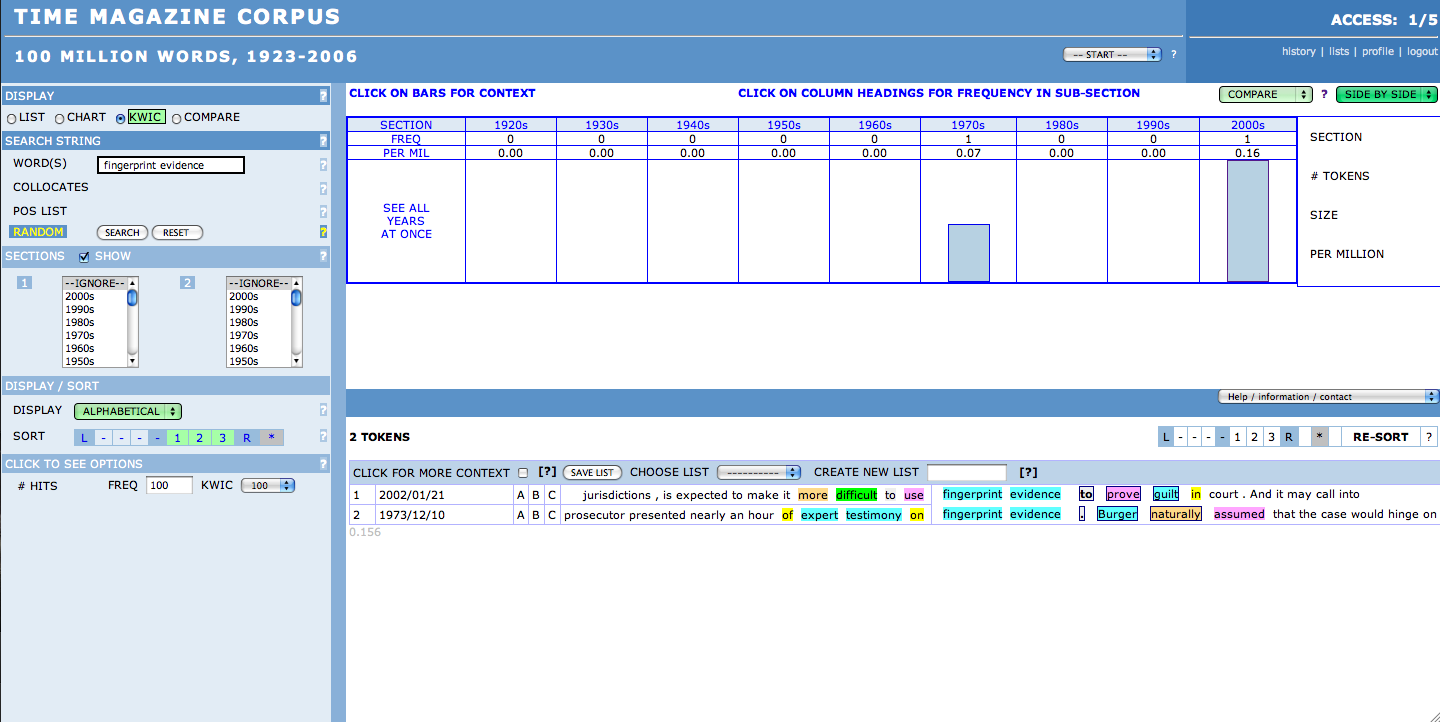Fingerprint evidence or as it is more commonly known as fingerprint recognition is one of the many automated way of verifying a person identity. It is very much connected to DNA in the way that it is unique in every person. With this information, I expected to see almost no mention of the phrase “fingerprint evidence” before the 1980’s. No one really knew anything about it prior to then so I expected to not see it. I did expect to see it begin to be mentioned the late 1980. I was expecting to see it jump drastically in the subsequent decades with the highest frequency in the 2000’s.
Here are my results:

Figure 8. This is a screenshot taken by my MacBook Pro of the the Time Magazine Corpus Text Mine of “fingerprint evidence”.
As you can see, there were only 2 hits on this mine. I took the privilege of getting more context. Here are the two sentences exactly as the Corpus has them listed. On Monday, Oct. 12,1973, Time Magazine wrote in the article “The Law: Burger Beefs”
While a teenager, he worked as a part-time Associated Press sports reporter and diagrammed plays for his high school team. Now Atlanta fans unfurl banners proclaiming themselves LEE’S LEGION. And, quite unexpectedly, they may find that their general has a chance to do battle in the Super Bowl. Once while sitting as a trial judge, Chief Justice Warren Burger listened patiently as a young prosecutor presented nearly an hour of expert testimony on fingerprint evidence. Burger naturally assumed that the case would hinge on a disputed fingerprint. To his consternation, he eventually discovered that the fingerprint was not in question at all; the defense accepted it. Not for the first or last time, Burger had been victimized by a familiar courtroom figure: the inept trial attorney (“The Law: Burger Beefs”, 1973).
Yes, in 1973, fingerprint evidence was mentioned only once, but that one mention was in a case to the supreme court with Chief Justice Warren Burger talking about it. Prosecutors have mentioned it before, but Time Magazine I guess never found it that necessary to talk about it. There is one more hit on “fingerprint evidence” on the corpus. It was mentioned in the article “The Week In Fingerprints” in Time Magazine. I include the extended context given to me by the Time Magazine Corpus.
Back in the U.S., police and prosecutors suffered a rude jolt from a court ruling that threw doubt on the validity of even the most sophisticated fingerprint analysis. Various defense lawyers had attempted for three years to get fingerprint analysis held to a rigorous standard for expert testimony set by a 1993 Supreme Court decision. Print-matching standards vary widely, the lawyers argued, and have never been scientifically proved. A Philadelphia judge finally agreed, and his ruling, while not binding in other jurisdictions, is expected to make it more difficult to use fingerprint evidence to prove guilt in court. And it may call into question other types of forensic testimony, like handwriting analysis and ballistics (“The Week In Fingerprints”, 2002).
This information did not bode well for prosecutors who counted on fingerprints, and the other mentioned forms of forensics evidence, for a conviction by a jury. The jury did not know if this evidentiary analysis was accurate so when you had an expert. The jury entrusted that the expert knew what he was talking about. It was more difficult as time progressed. It was only mentioned once in the 2000’s. It was on Jan. 21, 2002. The attack on the World Trade Center had just happened. There were other things that Time Magazine could have been talking about, but I want to try a little experiment of my own one more time. I project that my next page will have many more hits.
Previous: DNA Next: Fingerprints